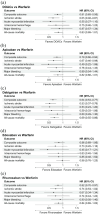Comparative effectiveness and safety of direct oral anticoagulants and warfarin in atrial fibrillation patients with dementia
- PMID: 39215489
- PMCID: PMC11569543
- DOI: 10.1177/23969873241274598
Comparative effectiveness and safety of direct oral anticoagulants and warfarin in atrial fibrillation patients with dementia
Abstract
Introduction: Developing an effective stroke prevention strategy is crucial for elderly atrial fibrillation (AF) patients with dementia. This is due to the limited and inconsistent evidence available on this topic. In this nationwide, population-based cohort study, we aim to compare the effectiveness and safety of direct oral anticoagulants (DOACs) and warfarin in AF patients with dementia.
Patients and methods: We identified AF patients with dementia, aged 50 years or older, from Taiwan's National Health Insurance Research Database between 2010 and 2019. The primary outcome was a composite of hospitalizations due to ischemic stroke, acute myocardial infarction, intracranial hemorrhage, or major bleeding, as well as all-cause mortality. We used 1:1 propensity score matching and Cox proportional hazard models to adjust for confounding factors when comparing outcomes between warfarin and DOAC (apixaban, dabigatran, edoxaban, or rivaroxaban) users or warfarin and each individual DOAC.
Results: There were 2952 patients in the DOAC-warfarin matched cohort. The apixaban-, dabigatran-, edoxaban-, and rivaroxaban-warfarin matched cohorts had 2346, 2554, 1684, and 2938 patients, respectively. The DOAC group, when compared to warfarin, was associated with a lower risk of both the composite outcome (hazard ratio (HR), 0.81; 95% confidence interval (CI) 0.69-0.95) and ischemic stroke (HR 0.65; 95% CI 0.48-0.87). Apixaban (HR 0.79; 95% CI 0.66-0.94), dabigatran (HR 0.64; 95% CI 0.53-0.77), and rivaroxaban (HR 0.82; 95% CI 0.70-0.97) were also associated with a lower risk of the composite outcome.
Discussion and conclusion: Compared to warfarin, DOACs, whether as a group or apixaban, dabigatran, or rivaroxaban individually, were associated with a reduced risk of the composite outcome in elderly patients with concurrent AF and dementia.
Keywords: Anticoagulation; atrial fibrillation; dementia; effectiveness; safety.
Conflict of interest statement
Declaration of conflicting interestsThe author(s) declared no potential conflicts of interest with respect to the research, authorship, and/or publication of this article.
Figures




References
-
- Tsao CW, Aday AW, Almarzooq ZI. Heart disease and stroke statistics—2023 update: a report from the American Heart Association. Circulation 2023; 147: e93–e621. - PubMed
-
- Elsheikh S, Hill A, Irving G, et al.. Atrial fibrillation and stroke: state-of-the-art and future directions. Curr Probl Cardiol 2024; 49(1 Pt C): 102181. - PubMed
-
- Hindricks G, Potpara T, Dagres N, et al.. 2020 ESC Guidelines for the diagnosis and management of atrial fibrillation developed in collaboration with the European Association of Cardio-Thoracic Surgery (EACTS)The Task Force for the diagnosis and management of atrial fibrillation of the European Society of Cardiology (ESC) Developed with the special contribution of the European Heart Rhythm Association (EHRA) of the ESC. Eur Heart J 2020; 42: ehaa612. - PubMed
-
- Joglar JA, Chung MK, Armbruster AL, et al.. 2023 ACC/AHA/ACCP/HRS Guideline for the diagnosis and management of atrial fibrillation: a report of the American College of Cardiology/American Heart Association Joint Committee on Clinical Practice Guidelines. Circulation 2023; 149: e1–e156. - PMC - PubMed
Publication types
MeSH terms
Substances
LinkOut - more resources
Full Text Sources
Medical

